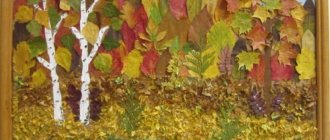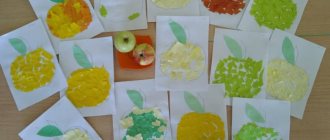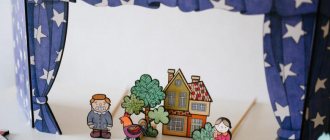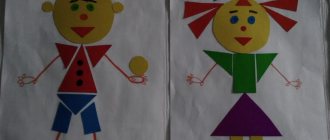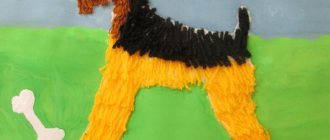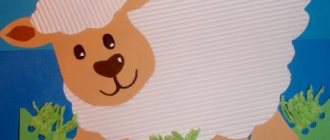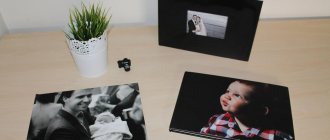Applique is an activity that promotes the all-round development of a child, and paper cut-out applique is one of the areas of creativity. Not only children, but also adults can work in this technique using various templates. Preschoolers and schoolchildren will find this application especially interesting. It will contribute to the development of fine motor skills, which is important for those who are just getting ready or starting to go to school.
Bunny made of paper
To create such a craft, pre-prepared templates with images of animals are perfect. In the photo of the broken appliqué you can see a bunny; thanks to the use of this technique, an interesting texture is created, the character looks more voluminous.
To create beautiful crafts, you can take templates by cutting them out of magazines, old coloring books, or print them from the Internet. You can also draw the figure yourself on paper or cardboard.
Crafts technique:
- Tear off the paper strips and then finely tear them into pieces.
- Glue these elements like a mosaic onto a pre-printed or drawn image.
- Try to make small distances between the pieces so that they do not overlap each other.
- The nose and eyes can also be torn from dark-colored paper or drawn on.
- Makes a great craft!
Templates
Templates for applications can be taken from anywhere. You can print them on our website, use your child’s old coloring books, or draw them yourself. Children can become the creators of such patterns themselves. Tearing paper for a picture is also not difficult: the main thing is to convince the child that this needs to be done carefully.
Cutting appliqué can play an important role in the development of a child’s fine motor skills if the baby is just learning to cut with scissors. He only recently picked them up and so far he only cuts any paper into small pieces. Take advantage of these moments. Offer to make a picture from cut-up colored paper. The baby will definitely be interested!
Snowman
Prepare a sheet of white paper and draw snowdrifts on it.
- Tear them off with your hands, following the drawn line.
- Now cut it into two parts.
- Blue or light blue cardboard will play the role of a background; stick snowdrifts on it.
- Attach different parts on top of each other to make the result look more realistic.
- Make templates with snowman parts from white paper.
- Carefully tear off the blanks along the pencil outline.
- You can glue the resulting circles to make a snowman; try to put the bottom border on the snowdrift to “put” the snowman on the snow.
- Cut out a headdress for a snowman from colored paper, buttons and parts of the face can be drawn with felt-tip pens.
- Decorate the craft further as you wish.
What does this type of activity provide?
Those parents who consider cut-off appliqué useless for the baby are far from right. Although there is no work with scissors, cut appliqué is indispensable for the formation of creative thinking. The child learns to place the drawing on the picture, to see what color the outline should be painted over.
At the same time, you shouldn’t let your toddler’s creativity run its course. He must understand that the colors in the picture must be close to reality, and that the gluing must be done carefully and evenly. These factors discipline the process of fantasy and thinking. At the very beginning, an adult should act as an organizer of the technical side of working with the application. And only when the preparatory stage is completed, you can start working!
Other application options
You can create entire paintings using the cut appliqué technique. This technique is perfect for children in the preparatory group of kindergarten.
You can tear off pieces, cut them and arrange them randomly. You can also beautifully outline the contours with markers or felt-tip pens and design an applique inside the image.
MAGAZINE Preschooler.RF
Abstract of the GCD “Break application” - “Porcini mushroom” in the middle groupGoal: to introduce children to a new technique of working with paper: tearing, performing work using the tearing appliqué technique.
Tasks:
Educational:
- introduce children to the technique of cut appliqué
- master the technique of cut appliqué
- expand children's knowledge about various methods of appliqué
Educational:
- develop children's imagination
- develop fine motor skills of hands
- develop interest in artistic creativity
- develop observation, memory, imagination, attention, logical thinking.
Educational:
- continue to develop emotional responsiveness in children
- cultivate interest in nature and aesthetic feelings.
Equipment and materials for carrying out GCD:
- cardboard with an outline image of a mushroom
- colored paper:
- brown (mushroom cap)
- beige (mushroom stem)
- green grass)
- glue
- glue brushes
- oilcloth - lining
Conducting GCD:
Organizational stage
Educator: - Hello children.
Children: - Say hello
Educator: Guys, this morning I met a forest dweller near the kindergarten. Want to know which one?
Children: Yes
Educator: then guess the riddle: “Under the pines, under the fir trees there lies a bag of needles . (Hedgehog)
Educator: That's right, well done.
Educator: The hedgehog told me a very sad story, he didn’t notice at all how autumn had come, but after autumn the cold season of the year, winter, will come. All the inhabitants of the forest have been collecting berries and mushrooms for a long time, but he has not collected anything. So a hedgehog came to our kindergarten to ask the children to help him collect mushrooms for his family, which they really like to eat in winter.
Educator: Guys, do you agree to help the hedgehog?
Children: Yes
Educator: Well then, today we will go to the forest where the hedgehog lives and we will collect only edible mushrooms, namely the white mushroom, because the white mushroom is the largest mushroom in the forest.
Physical education minute:
Kolya walked and walked and walked and found a porcini mushroom. One - fungus Two - fungus
Three - fungus, I put them in the box.
We looked at everything around us, there are no mushrooms anywhere anymore
And everyone sat down quietly. The teacher reads a poem, and the children imitate the movements of a mushroom picker: they walk,
bend down and put the mushrooms in the box.
Educator: Guys, look at what parts does the porcini mushroom consist of?
Children name the parts of the mushroom (leg, cap)
Educator: Well done.
The teacher shows pictures of mushrooms and an application with the image of a mushroom (ceps).
Children: Looking at pictures
Educator: Today we will make a mushroom (ceps)
To produce our works, we will use a very interesting and unusual type of applique: “Break applique”
You and I will not cut the paper, but tear it off, that’s why it’s called “BREAKING”.
Let's repeat it again:
Tear applique is obtained because we tear the paper and do not cut it with scissors.
Educator: Children, there is cardboard in front of you, and what do you see on the cardboard?
Children: Image of a mushroom.
Educator:
That's right - this is the outline of our mushroom. You also have colored paper on your table - brown, beige and green.
Educator: The paper needs to be torn into small pieces to design our application.
And now we will prepare our fingers for work.
Finger gymnastics “Mushrooms”
Amanita muscaria is a dangerous mushroom Children threaten with their index finger
And the second is a fox, a red-haired sister. Children extend their fingers one by one.
Third fungus mushroom, pink ear
And the fourth mushroom is the bearded old man morel
The fifth mushroom is white
Eat it with confidence!
Educator: Well done! We are ready to get to work.
Educator: First, you need to tear up pieces of paper.
We will tear off small pieces of brown paper from a sheet of paper, then beige and green.
Pieces of paper should be placed in different plates:
- brown (mushroom cap)
- beige (mushroom stem)
- green (grass)
Before we begin, we must review the safety rules when working with glue.
Next stage: Gradually fill in the silhouette of the mushroom with colored pieces.
Apply glue to the silhouette of the mushroom and gradually fill in the inner contours of the mushroom pattern (brown for the cap, beige for the stem, green for the grass) in a mosaic style.
Educator: What beautiful work you have done!
The work was done neatly and beautifully.
Hedgehog: Guys, what big porcini mushrooms you managed to find and make for my whole family. Thank you very much, now we will be full all winter.
Educator: Guys, what a great fellow we are, how many mushrooms we collected today. What mushrooms were we looking for for the hedgehog today?
Children: porcini mushrooms
Educator: Our porcini mushrooms are enough for the winter not only for the hedgehog’s family, but also for all the animals in the forest, let’s take the mushrooms to the clearing.
Children and the teacher organize an exhibition in the group or reception area.
Educator: This concludes our lesson.
| Next > |
Using napkins for applique
If you tear a napkin into small pieces and stick it on, you will create a volume effect and the craft will turn out airy.
If you are doing a craft with the image of trees, the trunks are cut out or drawn, and the leaves will be light, made from napkins. Pieces of napkins can also be rolled into balls.
Tear technique from napkins
Multi-colored napkins that tear into pieces will give the applique airiness and lightness.
The trees also come out great, the trunk is made as desired: cut, drawn or torn:
But the most beautiful thing is when you roll torn strips of napkins into arbitrary balls.
Application using cotton wool
- You will need a piece of cotton wool or cotton pads.
- You can give the children the task of tearing the cotton wool into small pieces.
- Draw images on a piece of cardboard.
- Pre-paint the cardboard or take a colored sheet.
- Decorate the background by gluing pieces of colored paper or painting it.
- Lay out and glue pieces of cotton wool inside the outlines drawn in pencil.
Using this technique, you can also create more complex images, where all the details of the composition, even the smallest ones, are made of cotton wool.
Applications from “palms”
Children's favorite hand appliques are also popular in winter themes. Green “palms” make a wonderful Christmas tree, which children can decorate to their taste with ready-made stars, bows (such shaped hole punches also exist), sparkles, buttons, sequins, and anything else.
Do you remember the poem “It was in January.”? Tell it to your child while you glue on ten bunny faces peeking out from under the Christmas tree paws.
Applique tree
In order to make such a magical tree, prepare colored paper, a glue stick or PVA glue and cardboard or a sheet of thick paper.
- To begin, draw the trunk and branches of a tree on a sheet of paper and color them; you can print the finished image from the Internet or trace it using a template.
- Now tear off small pieces of colored paper and glue them in the form of leaves.
- You can use various shades of paper - your tree can turn out to be both autumn and magical.
- The applique will look neater if the pieces of paper are the same.
- You can apply glue to the sheet of paper itself so that you don't have to apply colored paper to each piece.
“Fox” applique made using the cutting technique
You will need:
- White base
- Chanterelle pattern
- Paper in three colors: orange, black and white
- Glue
Execution stages. Trace the stencil or draw the fox yourself on a white base.
Take orange paper and tear it into random pieces.
Applying glue to each piece, we gradually fill the outline of the fox entirely. If the craft is being done by small children, it is better to cover the entire chanterelle - the base - with glue and stick the dry pieces from bottom to top.
Tear off two small, approximately identical pieces of black paper—the eyes—and glue them onto the fox. Another part will be needed for the spout. Tear off a small piece from a white sheet and make the tip of the fox's tail. Our fox is ready.
You can also not prepare pieces of paper in advance, but tear them off from the strip at the gluing site. Watch the video to see how this is done.
Landscape made of paper
In order to create an entire landscape using the cut-out appliqué technique, you will need several sheets of colored paper, as well as pencil glue and a sheet of cardboard as a base.
- Now the most fun part of the job is tearing and crumpling colored paper.
- If you use crumpled paper to create a composition, it will look even more interesting and voluminous.
- Now you can collect parts for a future application.
- Develop your child's imagination by asking him what a piece of paper looks like.
- This way you can find creative and unexpected solutions.
- In addition, for children this is a real game, so the creative process will become even more interesting. If you have already outlined the elements of the picture on a sheet of paper, you can safely glue the details to the base.
- Attach the corners first so you can experiment by moving the paper pieces around.
When the picture is ready, carefully glue all the parts and let them dry thoroughly. The picture is ready, you can decorate it if you want and put it in a frame.
Principle of operation
Paper crafts using the cut appliqué technique are made in 2 main ways.
Simple option
This option is suitable for the youngest children.
The stages of such creativity are as follows:
| № | Stage | Description |
| 1 | Preparing the template | At the initial stage, an adult (parent or teacher) must select a drawing suitable for the work - an outline on the basis of which the craft will be made. In this case, you can take a ready-made drawing or draw it yourself. When there is a background, all that remains is to put a picture on it. Its elements are torn off from colored paper and then glued to the main canvas. It is important to keep in mind that a large number of parts will be glued to the top of the canvas. |
| 2 | Selecting Colored Paper | The paper that serves as the background for this craft must be thick enough, so when choosing, you should pay attention not only to the color of the base, but also to the thickness. Children can be involved in the work. Along with them, you can choose the color of the paper that will be used for filling. After this, the child himself begins to tear off pieces of any size. |
| 3 | Gluing paper to background | It is necessary to take each piece of paper, apply an adhesive substance to one of its surfaces, and then apply it to the base one by one. It is most convenient to use a glue stick, because with its help you can evenly distribute the adhesive over the surface. When the space is filled, the work is completed. The result is a monochrome product, much like a mosaic. |
The option is more complicated
Cut-out paper applique (templates for products can be classic or abstract) always starts with an idea. After choosing a suitable example, the child begins to do everything independently, but at the same time, an adult must supervise his creative process in order to prevent mistakes.
Tear paper applique on a fairy tale theme
The stages of the complex version are as follows:
- Take thick colored paper. It can be any color.
- Attach a stencil to thick colored paper and trace it. If desired, you can apply a design to the surface of the paper without using a stencil.
- Select thin paper of the desired color and start tearing pieces from it.
- Fill the space with torn paper pieces. To do this, an adhesive is applied to each fragment; it is best to use a glue stick.
- After filling the entire space, the work is considered completed.
Decoration of the composition
When the painting is ready, you can decorate it using all kinds of materials to give it a finished look and make the work unique.
- A few shells, dried flowers and leaves, ribbons, bows, buttons, beads, beads, rhinestones are perfect for this (adults should supervise the children’s work, especially if small parts are used in the process of creating a masterpiece).
- The resulting creation can be inserted into a beautiful frame. And then the child can safely participate in competitions with his works.
All these ideas will help you and your children create real masterpieces using a minimum of materials. And most importantly, this is a very fun and interesting process that can become leisure time for the whole family.
The finished work can become a wonderful interior decoration, and you can also present it at any children's craft competition. Such educational crafts will be very useful for teaching in kindergarten.
There are a lot of different techniques of varying complexity; you can choose something suitable for the creativity of children of different ages, from the youngest to the preparatory group.
Examples of finished works
The finished cut-out appliqué looks very much like a mosaic, especially if there is little space left between the pieces of paper. Here are examples of such applications:
For older children or schoolchildren, you can choose more serious subjects. In Ancient History lessons, the teacher may well suggest making Egyptian frescoes out of paper!
In general, cut-out applique as a type of children's creativity is quite suitable for kindergartens, aesthetic centers, and lower grades of school.
An alternative material for making cut-out appliqué can be multi-colored double-sided tape or adhesive-backed note paper. Scotch tape, of course, is a more expensive method, but the baby will not need to get dirty with glue. Simply tear off a piece, remove the base and stick it on paper. Ideal for kindergarten!
Photo of broken applique
Velvet applications
Among the various photos of winter appliqué, there are many interesting options using multi-colored velvet and woolen threads. You can cut a mitten or a hat from velvet. The top of the hat can be decorated with a real pom-pom made of thread or a cotton ball; the bottom of the mitten can be covered with scraps of cotton wool, which will depict a fur edge.
You can embroider a snowflake on a mitten with woolen thread or depict a knitted pattern with pieces of multi-colored velvet. And the hat can be striped from different colors of velvet.

